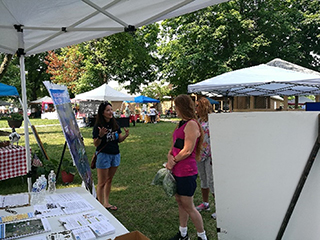Partnerships for Environmental Public Health (PEPH)
Study Location: Indiana
Academic Partners:
Purdue University
Sa Liu, Ph.D.
Brandon Boor, Ph.D.
University of Illinois at Chicago
Mary Ellen Turyk, Ph.D.
Eve Pinsker, Ph.D.
Jeni Hebert-Beirne, Ph.D.
Hua Yun Chen, Ph.D.
Indiana University
David Kareken, Ph.D.
Devin Mackay, M.D.
Community Partners:
Martinsville Community Advisory Board and Engagement Team
Bethaney Latham
Stephanie Wesseler
Wade Catt
The Claire E. and Patrick G. Mackey Children's Cancer Foundation
Joe Mackey
Project Description
Tetrachloroethylene (PCE) is a common industrial chemical used in dry cleaning, degreasing metal parts, and manufacturing other chemicals. It is detectable in many hazardous waste sites across the United States. Exposure to PCE has been linked to a variety of health problems, including cancer and neurotoxicity.
Health effects from high exposure levels among workers using PCE on the job and people living near businesses that use PCE are well documented. However, few studies have assessed the effects of PCE exposure on communities living near contaminated sites where residents continuously encounter lower levels of PCE over long periods of time and through multiple pathways. How PCE interacts with other common contaminants to affect health is also poorly understood.
Investigators from Purdue University, the University of Illinois at Chicago, and Indiana University have developed a community-engaged research program to study the effects of environmental PCE exposure in Martinsville, Indiana, a community of 11,000 people that sits above four groundwater contamination sites. The contaminated aquifer contains primarily PCE and trichloroethylene (TCE), a chemical in the same class — chlorinated volatile organic compounds (CVOCs) — as PCE.
Since 2005, a filtration system has been in place that uses activated carbon to remove PCE and other COVS from Martinsville municipal water, which now meets drinking water standards set by the U.S. Environmental Protection Agency. However, growing evidence suggests that PCE is migrating from groundwater and soil into buildings above ground in vapor form and contaminating indoor air, with potential health consequences for Martinsville residents.
More than half of residents in Martinsville are long-term renters who are likely disproportionately affected by PCE, due to a lack of legal requirements for landlords to disclose contamination and renters’ inability to test for PCE without landlords’ permission. Many of the residents already experience economic or social marginalization, suggesting that PCE contamination near their homes is an environmental justice issue as well as a health issue.
The project’s long-term goal is to understand health effects of PCE exposure in communities, and to empower community members’ participation in environmental health decision-making. A transdisciplinary academic team is leading the research, in partnership with two community-based organizations. The research team is also partnering with an existing community advisory board.
Specific project aims:

- Address the community’s concerns about elevated cancer rates using Indiana State Cancer Registry data.
- Assess the Martinsville community’s concerns and perceptions about the contamination and associated health risks across the five-year project.
- Design and implement an educational campaign to promote testing for PCE and other CVOCs and installation of mitigation systems when residential contamination levels exceed exposure limits. The team’s focus will be on promoting property owners’ and landlords’ participation in testing for PCE evaporating from the contaminated groundwater into indoor air, and in remediation activities.
- Help determine the level of PCE contamination at hazardous waste sites that warrants investigation and risk assessment.
- Provide guidance to other communities facing similar contamination threats.
- Provide information to motivate the community to participate in the remediation decision-making process.
- Quantify current exposure to PCE and other CVOCs in indoor air and exhaled breath from 300 residents using a highly sensitive assessment tool called a proton transfer reaction time-of-flight mass spectrometer.
- Use modeling to estimate CVOC exposures among residents over time; investigate associations between exposures and visual and cognitive abilities.


